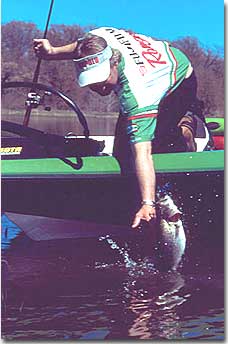The Serpent Solution
The Serpent Solution
By Noel Vick
By Scott Bonnema
A snake charmer removes the lid from vase-shaped wicker basket. Sitting cross-legged, he presses his lips to a wooden flute and plays an evocative tune. The woven container stirs. Soon, the flared hood of a king cobra appears. Arched and mesmerized, the beast climbs as its tongue flicks, sensing the air. The haunting string of notes seems to captivate and control the asp, but onlookers wisely keep their guards up nonetheless.
 Although not as dramatic, nor as dangerous, I grow a wee bit anxious, almost unnerved, each time I open my serpent box. It’s plastic, not wicker, and the contents aren’t alive or poisonous, but they are snakelike and unquestionably the longest lures a bass will ever see and swipe.
Although not as dramatic, nor as dangerous, I grow a wee bit anxious, almost unnerved, each time I open my serpent box. It’s plastic, not wicker, and the contents aren’t alive or poisonous, but they are snakelike and unquestionably the longest lures a bass will ever see and swipe.
The snakes I speak of are 8, 10, and even 12-inch soft-plastic worms, monstrous creatures for sure. And such substantial presentations aren’t for rank and file fish or random times of the year either. Rather, these squishy serpents are reserved for big fish – 3-pounders plus – and best offered near the end of summer and early fall. That’s when the largest bass in a system are desperately focused on food.
Before discussing where to unleash serpents, its best to first describe the bait itself. Numerous manufacturers pour the plastic for 8-inch plus worms, and through extensive experimentation, I’ve settled on a few favorites. The Zoom 10 ½-inch Ole Monster slithers and slides, as do 10 and 12-inch, two-tone original Culprit worms. Another entry that’s quickly moving up my charts is the 8-inch Storm Rattle Thunder Worm, which features a self-contained rattle chamber.
I want to take a moment to ease your concerns about the size of the worms in question. Yes, they’re enormous, but certainly nothing a self-respecting bass can’t engulf, especially in autumn when appetites escalate. Back when I was living in California, 12 to 16-inch plastics were the rage. Sure, the Eureka State is notorious for largemouths in the 10 to 15-pound class, but I snatched heaps of 4 and 5-pounders on foot long worms too. Bass naturally munch forage head first, including ruler-length plastic worms, subsequently accounting for the hooking success
On the subject of rattles, regardless if the mega-worm offers its own sound effects or not, more must be added. In between the synthetic-snake, which is Texas-rigged, and bullet sinker I thread one maybe two glass beads. Not the plastic-sort of beads used for slip-bobber fishing either, but ones formed from genuine wine bottle and windshield glass. Authentic glass beads clanking against one another or a single bead banging into a sinker makes a boatload of racket and is proven to draw bass from serious cover. Note, too, that glass striking a brass bullet-sinker creates even louder resonations than it does contacting a traditional, softer, lead weight. Glass beads are available through online tackle outlets, select sporting goods stores, and hobby and craft shops.
So now you’ve got serpent’s profile that clicks like a crayfish in the rocks. That should infuriate a few bucketmouths, or at the least stimulate curiosity. The next order of business is locating some grass for your snake to slither through.
In early fall, largemouth bass clamber atop vegetated points, bars, and lush flats. Coontail is the preferred backdrop, but remaining green cabbage invites suitors as well. Typically, weeded lots in 5 to 10-feet of water see the most fish, particularly along foliated edges and where vegetation crosses paths with rocks and other hard spots, like gravel.
Whipping and working the python is a study in hops and waggles. Hurl the worm out there, let is greet the lake floor, and give it a stern shaking. Permit the glass and brass to interact and tempt fish in. Be patient, too, as it might take 30 seconds or more to beckon a bass from the thick stuff.
Reel-up a taste and leap to the next jiggling position. Shake, shake, pause…shake, shake, pause, etc. The majority of collisions come during the shaking phase; so keep the line taunt, rod tip low or pitched to 45-degrees, and a hot hand on the lever.
Perhaps the most positive attribute of monster worm rigging is its capacity to excavate bass during the day. Few presentations can rouse a latent bass, let alone cause the fish to chase and chomp.
Try and set aside your ophiciophobia (fear of snakes). Remember that the ones you’ll be issuing are synthetic, supple, and free of fangs and rattles; piercing eyes and forked tongue as well. Bass have learned to love ‘em, or possibly despise the reptiles, which explains the voracious hits. Anyhow, it’s evident that bass aren’t afraid of snakes.
Editor’s note: Scott Bonnema is a touring professional who fishes bass tournaments and offers instructional seminars throughout the Midwest. He’s a member of the Rapala Team, and Pro Staffs of Fuji Film, Northland Tackle, Ranger Boats and Mercury Outboards.
|
